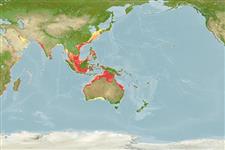Common names from other countries
Classification / Names / Names
Namen | Synonyme | Catalog of Fishes (gen., sp.) | ITIS | CoL | WoRMS
Environment: milieu / climate zone / depth range / distribution range
Ökologie
Benthopelagisch; tiefenbereich 0 - 200 m (Ref. 81173), usually 1 - 40 m. Tropical; 30°N - 37°S, 32°E - 178°W
Indo-Pacific: Dugong dugon hemprichii: Red Sea, Aqaba, Suez Canal; Dugong dugon dugon: Gulf of Aden, Mozambique, Persian Gulf, Pakistan, India, Myanmar, Malay Peninsula, Gulf of Thailand, Vietnam, Gulf of Tonkin, Comoros, Madagascar, Mauritius, Rodriguez, Sri Lanka, Andaman Islands, Indonesia, Ryukyu, Taiwan, Philippines, Guam, Palau, Micronesia, Caroline Is, Papua New Guinea, Solomon, New Caledonia, Australia, Fiji (Ref. 1522).
Length at first maturity / Size / Gewicht / Alter
Maturity: Lm ? range ? - ? cm Max length : 406 cm TL Männchen/unbestimmt; (Ref. 91927); max. veröff. Gewicht: 400.0 kg (Ref. 1394); max. veröff. Alter: 20 Jahre (Ref. 91927)
Maximum diving depth of 20.5 m recorded from Australia (Ref. 81173). Found in inshore waters, in bays and channels (Ref. 1394). Favors areas with warm shallow water, inshore and reefal seagrass beds (Ref. 936), particularly on fine sand (Ref. 86921). Occurs in small groups of up to 6 individuals; though, an exception of a herd of to 600 individuals was once recorded between Bahrain and Qatar (Ref. 801). Population estimates in the Persian/Arabian Gulf range from 5800 to 7300 individuals. Has a larger range than previously known, where their present range may be about 74% of the historical range (Ref. 114880). Feeds on a variety of seagrasses (Ref. 936). Almost entirely dependent on seagrass for food (Ref. 114880). Preyed upon by tiger sharks (Ref. 49538). Faces threats in the Persian/Arabian Gulf such as dredging, trawling and land reclamation, all damaging their critical seagrass habitats (Ref. 114880).
Tan, J.M.L. 1995. (Ref. 936)
IUCN Rote Liste Status (Ref. 130435)
CITES Status (Ref. 108899)
Nutzung durch Menschen
Fischereien: nicht kommerziell
FAO - Fischereien: Artbeschreibung | FishSource | Sea Around Us
Tools
Internet Quellen
Estimates based on models
Preferred temperature
(Ref.
115969): 24 - 29, mean 27.8 (based on 1686 cells).
Widerstandsfähigkeit
hoch, Verdopplung der Population dauert weniger als 15 Monate. (K=1.26-1.62; tm=12.3; tmax=20).
Verwundbarkeit
Very high vulnerability (90 of 100).
Preiskategorie
Unknown.
